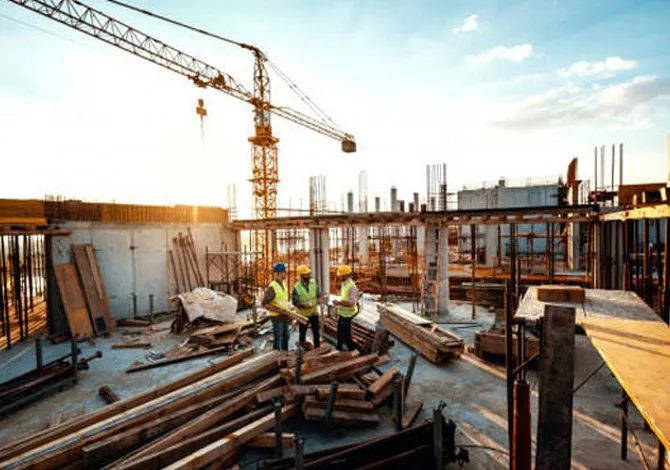-
CENTRES
Progammes & Centres
Location
Increased spending on infrastructure boost is expected to boost employment generation and increase aggregate demand, thereby, accelerating growth

This piece is part of the essay series, Amrit Kaal 1.0: Budget 2023
Since the outbreak of the COVID-19 pandemic in 2020, the priorities of the Union Budget have shifted from supporting the survival of the Indian economy in 2021, directing its recovery in 2022, to accelerating the momentum of its growth in 2023. The Budget identified critical dimensions of India’s growth story: Sustainable and inclusive development, the need to leave no one behind, concerns about infrastructure, strengthening governance, green transition, leveraging the demographic dividend, and the financial sector. The objective of this article is to understand the importance accorded to infrastructure by the budget. The level of importance given will serve as the barometer of how infrastructure has been leveraged in the growth process of the economy.
One of the major highlights of the Budget is that the capital investment outlay in the current Budget is three times the outlay in 2019-20. The capital expenditure and the effective capital expenditure, which are budgeted at INR 10 lakh crore and INR 13.7 lakh crore will account for 3.3 percent and 4.5 percent of GDP respectively. The Budget speech enumerated the measures to be undertaken by the central government to support the states and the private sector in boosting investments in infrastructure. The speech mentioned the launch of 100 transport infrastructure projects, which have been allocated an outlay of INR 75,000 crores. The focus of the infrastructure and investment priority in the Budget speech was significantly on urban infrastructure, particularly on sustainable cities.
One of the major highlights of the Budget is that the capital investment outlay in the current Budget is three times the outlay in 2019-20.
If we take into account the budgetary allocations of the ministries of civil aviation, communications, housing and urban affairs, new and renewable energy, power, ports, shipping and waterways, railways, and road transport and highways, which represent transport and communications, green and urban infrastructure, it turns out that 16.6 percent of the total expenditure and 2.5 percent of GDP in budget 2023 is dedicated to infrastructure. This represents an increase from the previous year’s budget, which allocated 14.1 percent of total expenditure and 2.15 percent of GDP to infrastructure.
The budgetary allocation to the Ministry of Civil Aviation saw a cut of 70 percent, owing to reduced liabilities as a result of Air India’s privatisation. The Budget speech emphasised the need for enhancing regional air connectivity by reviving several critical aviation infrastructure projects. Accordingly, the budget has increased the allocation for the regional connectivity scheme from INR 600.71 crores last year to INR 1244.07 crores this year, a spike of about 107.09 percent.
There has been a 17 percent increase in the budgetary allocation made to the Ministry of Communications. Of this increase, 55 percent is reflected in the allocations to revenue expenditure while 45 percent is reflected in capital expenditure. The budget aspires to establish 100 labs for creating solutions using 5G services in engineering institutions, which can give rise to new businesses and generate new jobs. The labs will focus on smart solutions in the domains of education, agriculture, transport, and healthcare.
Although a lot of thrust was placed on urban infrastructure in the Budget speech, the allocation to the Ministry of Housing and Urban Affairs has remained more or less the same. The focus was on the importance of financing urban infrastructure and the need to address the concerns of urban sanitation apart from prioritising sustainable urban centres.
The Budget speech emphasised the need for enhancing regional air connectivity by reviving several critical aviation infrastructure projects.
The budgetary allocation to the Ministry of New and Renewable Energy saw an increase of 48 percent from INR 6900.68 crores to INR 10,222 crores, reflecting the priority accorded to renewable energy infrastructure by the Central Government. This increased expenditure has been allocated to off-grid solar power projects, Pradhan Mantri Kisan Urja Suraksha Evam Uhan Mahabhiyan (PM-KUSUM) scheme, National Green Hydrogen Mission, Green Energy Corridor, bio energy programme, and grid-connected solar and wind power projects.
The Central Government has sought to promote coastal shipping as cost effective and energy efficient by leveraging public-private partnership models and relying on viability gap funding. The Budget has increased allocation to the Ministry of Ports, Shipping and Waterways by 30 percent from the previous year. This increase is reflected in the capital outlay of the ministry.
The budgetary allocation of the Ministry of Power saw an increase in outlay of 29 percent from the previous year. A large part of this increase will fund the revenue expenditure of the central sector schemes and projects of the ministry.
The Ministry of Railways saw its budget allocation increase by a whopping 72 percent from the previous year. All of the increase is accounted for by the capital outlay on the Indian Railways. The capital outlay is expected to be spent on priority projects namely, 500 planned Vande Bharat Express trains, achieving 100 per cent electrification, and makeover of 1,275 stations under the Amrit Bharat scheme.
The budgetary allocation to the Ministry of New and Renewable Energy saw an increase of 48 percent from INR 6900.68 crores to INR 10,222 crores, reflecting the priority accorded to renewable energy infrastructure by the Central Government.
The Ministry of Road Transport and Highways also saw its budgetary allocation increase by 36 percent from last year. The increase is reflected in the rise in capital expenditure of the Ministry. This hike in budgetary allocation will enable the government to achieve the 25,000-km road development target announced in the 2022-23 Budget.
As is clear, the Budget in this year has significantly ramped up the expenditure on infrastructure. Every rupee spent on capital expenditure has a multiplier effect of INR 2.45 in the immediate year, and INR 3.14 in the following years. The expenditure on infrastructure will set into motion the capex multiplier effect. The multiplier effect unleashed by infrastructure spending is expected to rely on cost reduction, enhanced productivity, and increased efficiency to boost employment generation and increase aggregate demand, thereby, accelerating growth.
The views expressed above belong to the author(s). ORF research and analyses now available on Telegram! Click here to access our curated content — blogs, longforms and interviews.

Renita DSouza is a PhD in Economics and was a Fellow at Observer Research Foundation Mumbai under the Inclusive Growth and SDGs programme. Her research ...
Read More +